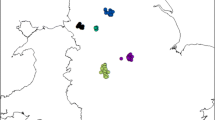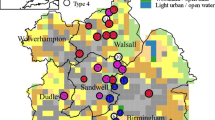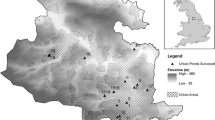Abstract
Urbanisation is one of the greatest threats to freshwater biodiversity, with the area of land covered by towns and cities predicted to increase significantly in the future. Ponds are common features in the urban landscape and have been created for a variety of reasons ranging from ornamental/amenity purposes through to the detention of urban runoff and pollution. This paper aims to quantify the aquatic macroinvertebrate biodiversity associated with garden, ornamental and other urban ponds in Leicestershire, UK. We examined the macroinvertebrate biodiversity of 41 urban ponds (13 garden, 12 park and 16 other urban ponds) within the town of Loughborough, UK. Park ponds supported greater macroinvertebrate richness than garden or other urban ponds. Garden ponds were the most taxon poor. Pond size was strongly correlated with macroinvertebrate diversity. Collectively, urban ponds were found to be physically and biologically heterogeneous and were characterised by high community dissimilarity. Urban ponds provide a diverse range of habitats for a mixture of common and rare aquatic macroinvertebrate taxa and represent a valuable biodiversity resource within anthropogenically dominated landscapes. Recognition of the significant contribution of ponds to urban freshwater biodiversity is important for future aquatic conservation within anthropogenically dominated landscapes.




Similar content being viewed by others
References
Bardsley, L., 2012. The Wildlife Pond Handbook: a practical guide to creating and maintaining your own wetland for wildlife. New Holland Publishers, London.
Biggs, J., A. Corfield, D. Walker, M. Whitfield & P. Williams, 1994. New approaches to the management of ponds. British Wildlife 5: 273–287.
Biggs, J., G. Fox, M. Whitfield & P. Williams, 1998. A guide to the methods of the National Pond Survey. Pond Action, Oxford.
Biggs, J., P. Williams, M. Whitfield, P. Nicolet & A. Weatherby, 2005. 15 years of pond assessment in Britain: results and lessons learned from the work of pond conservation. Aquatic Conservation: Marine and Freshwater Ecosystems 15: 693–714.
Boothby, J., 1995. Sustaining a threatened landscape: farmland ponds in Cheshire. Journal of environmental planning and Management 38: 561–568.
Brand, A. B. & J. W. Snodgrass, 2009. Value of artificial habitats for amphibian reproduction in altered landscapes. Conservation Biology 24: 295–301.
Briers, R. A., 2014. Invertebrate communities and environmental conditions in a series of urban drainage ponds in Eastern Scotland: implications for biodiversity and conservation value of SUDS. Clean — Soil, Air, Water 42: 193–200.
Chester, E. T. & B. J. Robson, 2013. Anthropogenic refuges for freshwater biodiversity: their ecological characteristics and management. Biological Conservation 166: 64–75.
Clarke, K. R. & R. N. Gorley, 2006. PRIMER v6: user manual/tutorial. PRIMER E-Ltd, Plymouth, UK.
Colding, J., J. Lundberg, S. Lundberg & E. Andersson, 2009. Golf courses and wetland fauna. Ecological Applications 19: 1481–1491.
Dallimer, M., Z. Tang, P. R. Bibby, P. Brindley, K. J. Gaston & Z. G. Davies, 2011. Temporal changes in green space in a highly urbanized region. Biology Letters 7: 763–766.
Davies, B. R., J. Biggs, P. Williams, M. Whitfield, P. Nicolet, D. Sear, S. Bray & S. Maund, 2008. Comparative biodiversity of aquatic habitats in the European agricultural landscape. Agriculture, Ecosystems and Environment 125: 1–8.
Davies, Z. G., R. A. Fuller, A. Loram, K. N. Irvine, V. Sims & K. J. Gaston, 2009. A national scale inventory of resource provision for biodiversity within domestic gardens. Biological Conservation 142: 761–771.
DCPWA (2014) Derby City Pond Warden Association Website. Available at: http://www.dcpwa.org.uk/ [Access Date: 30th April 2015].
Dudgeon, D., et al., 2006. Freshwater biodiversity: importance, threats, status and conservation challenges. Biological Reviews 81: 163–182.
Fontana, S., T. Sattler, F. Bontadina & M. Moretti, 2011. How to manage the urban green to improve bird diversity and community structure. Landscape and Urban Planning 101: 278–285.
Gaston, K. J., R. M. Smith, K. Thompson & P. H. Warren, 2005a. Urban domestic gardens (II): experimental test of methods for increasing biodiversity. Biodiversity and Conservation 14: 395–413.
Gaston, K. J., P. H. Warren, K. Thompson & R. M. Smith, 2005b. Urban domestic gardens (IV): the extent of the resource and its associated features. Biodiversity and Conservation 14: 3327–3349.
Gledhill, D. G., P. James & D. H. Davies, 2008. Pond density as a determinant of aquatic species richness in an urban landscape. Landscape Ecology 23: 1219–1230.
Goddard, M. A., A. J. Dougill & T. G. Benton, 2010. Scaling up from gardens: Biodiversity conservation in urban environments. Trends in Ecology and Evolution 25: 90–98.
Goertzen, D. & F. Suhling, 2013. Promoting dragonfly diversity in cities: major determinants and implications for urban pond design. Journal of Insect Conservation 17: 399–409.
Google Earth, 2015. https://earth.google.com [last accessed 18/03/2015].
Gopal, B., 2013. Future of wetlands in tropical and subtropical Asia, especially in the face of climate change. Aquatic Sciences 75: 39–61.
Grimm, N. B., S. H. Faeth, N. E. Golubiewski, C. L. Redman, J. Wu, X. Bai & J. M. Briggs, 2008. Global change and the ecology of cities. Science 319: 756–760.
Guneralp, B. & K. C. Seto, 2013. Futures of global urban expansion: uncertainties and implications of biodiversity conservation. Environmental Research Letters 8: 1–10.
Hassall, C., 2014. The ecology and biodiversity of urban ponds. Wiley Interdisciplinary Reviews: Water 1: 187–206.
Hassall, C. & S. Anderson, 2015. Stormwater ponds can contain comparable biodiversity to unmanaged wetlands in urban areas. Hydrobiologia 745: 137–149.
Hassall, C., J. Hollinshead & A. Hull, 2012. Temporal dynamics of aquatic communities and implications for pond conservation. Biodiversity and Conservation 21: 829–852.
Heal, K. V., D. A. Hepburn & R. J. Lunn, 2006. Sediment management in sustainable urban drainage system ponds. Water Science and Technology 53: 219–227.
Hill, M. J. 2015. Aquatic macroinvertebrate biodiversity of lowland rural and urban ponds in Leicestershire. Unpublished PhD thesis, Loughborough University.
Hinden, H., B. Oertli, N. Menetrey, L. Sager & J. Lachavanne, 2005. Alpine pond biodiversity: what are the related environmental variables. Aquatic Conservation: Marine and Freshwater Ecosystems 15: 613–624.
Jeffries, M. J., 2011. The temporal dynamics of temporary pond macroinvertebrate communities over a 10 year period. Hydrobiologia 661: 391–405.
Langley, J. M., S. Kett, R. S. Al-Khalili & C. J. Humphrey, 1995. The conservation value of English urban ponds in terms of their rotifer fauna. Hydrobiologia 313(314): 259–266.
Le Viol, I., J. Mocq, R. Julliard & C. Kerbiriou, 2009. The contribution of motorway stormwater retention ponds to the biodiversity of aquatic macroinvertebrates. Biological Conservation 142: 3163–3171.
Legendre, P. & H. J. B. Birks, 2012. From classical to canonical conservation. In Birks, H. J. B., A. F. Lotter, S. Juggins & J. P. Smol (eds), Tracking Environmental Change Using Lake Sediments, Volume 5: Data Handling and Numerical Techniques. Springer, Dordrecht: 201–248.
Legendre, P. & E. D. Gallagher, 2001. Ecologically meaningful transformations for ordination of species data. Oecologia 129: 271–280.
Leps, J. & P. Smilauer, 2003. Multivariate Analysis of Ecological Data Using CANOCO. Cambridge University Press, Cambridge.
Mcdonald, R. I., P. Kareiva & R. T. T. Forman, 2008. The implications of current and future urbanization for global protected areas and biodiversity conservation. Biological Conservation 141: 1695–1703.
McKinney, M. L., 2002. Urbanization, biodiversity and conservation. Bioscience 52: 883–890.
McKinney, M. L., 2008. Effects of urbanization of species richness: a review of plants and animals. Urban Ecosystems 11: 161–176.
Nakanishi, K., T. Nishida, M. Kon & H. Sawada, 2014. Effects of environmental factors on the species composition of aquatic insects in irrigation ponds. Entomological Science 17: 251–261.
Nicolet, P., J. Biggs, G. Fox, M. J. Hodson, C. Reynolds, M. Whitfield & P. Williams, 2004. The wetland plant and macroinvertebrate assemblages of temporary ponds in England and Wales. Biological Conservation 120: 261–278.
Niinemets, U. & J. Penuelas, 2008. Gardening and urban landscaping: significant player in global change. Trends in Plant Science 13: 60–65.
Nilsson, A. N. & B. W. Svensson, 1995. Assemblages of dytiscid predators and culicid prey in relation to environmental factors in natural and clear-cut boreal swamp forest pools. Hydrobiologia 308: 183–196.
Noble, A. & Hassall, C. 2014. Poor ecological quality of urban ponds in northern England: causes and consequences. Urban Ecosystems: 1–14.
Oertli, B., D. A. Joye, E. Castella, R. Juge, D. Cambin & J. B. Lachavanne, 2002. Does pond size matter? The relationship between pond area and biodiversity. Biological Conservation 104: 59–70.
Paul, M. J. & J. L. Mayer, 2001. Streams in the urban landscape. Annual Review of Ecology and Systematics 32: 333–365.
Pisces Conservation, 2004. Community Analysis Package Version 3.0. Pisces Conservation Ltd, Lymington, UK.
Pisces Conservation, 2008. Species Diversity and Richness IV. Pisces Conservation Ltd, Lymington, UK.
Ruggiero, A., R. Cereghino, J. Figuerola, P. Marty & S. Angelibert, 2008. Farm ponds make a contribution to the biodiversity of aquatic insects in a French agricultural landscape. Comptes Rendus Biologies 331: 298–308.
Santoul, F., A. Gaujard, S. Angelibert, S. Mastrorillo & R. Cereghino, 2009. Gravel pits support waterbird diversity in an urban landscape. Hydrobiologia 634: 107–114.
Scher, O. & A. Thiery, 2005. Odonata, amphibian and environmental characteristics in motorway stormwater retention ponds (Southern France). Hydrobiologia 551: 237–251.
Semlitsch, R. D. & J. R. Bodie, 2003. Biological criteria for buffer zones around wetlands and riparian habitats for amphibians and reptiles. Conservation Biology 17: 1219–1228.
Seto, K. C., B. Guneralp & L. R. Hutyra, 2012. Global forecasts of urban expansion to 2030 and direct impacts on biodiversity and carbon pools. Proceedings of the National Academy of Sciences 109: 16083–16088.
Scheffer, M., G. J. van Geest, K. Zimmer, E. Jeppersen, M. Sondergaard, M. G. Butler, M. A. Hanson, S. Declerck & L. De Meester, 2006. Small habitat size and isolation can promote species richness: second-order effects on biodiversity in shallow lakes and ponds. Oikos 112: 227–231.
Shochat, E., S. B. Lerman, J. M. Anderies, P. S. Warren, S. H. Faeth & C. H. Nilon, 2010. Invasion, competition, and biodiversity loss in urban ecosystems. Bioscience 60: 199–208.
Smith, R. K. & W. J. Sutherland, 2014. Amphibian Conservation: Global Evidence for the Effects of Interventions. Pelagic Publishing, Exeter.
Sushinsky, J. R., J. R. Rhodes, H. P. Possingham, T. K. Gill & R. A. Fuller, 2013. How should we grow cities to minimize their biodiversity impacts? Global Change Biology 19: 401–410.
United Nations, 2014. World Urbanization Prospects: the 2014 revision. United Nations, New York.
Urban, M. C., D. K. Skelly, D. Burchsted, W. Price & S. Lowry, 2006. Stream communities across a rural-urban landscape gradient. Diversity and Distributions 12: 337–350.
Van de Meutter, F., R. Stoks & L. De Meester, 2005. The effect of turbidity state and microhabitat on macroinvertebrate assemblages: a pilot study of six shallow lakes. Hydrobiologia 542: 379–390.
Vermonden, K., R. S. E. W. Leuven, G. van der Velde, M. M. van Katwijk, J. G. M. Roelofs & A. Jan Hendriks, 2009. Urban drainage systems: an undervalued habitat for aquatic macroinvertebrates. Biological Conservation 142: 1105–1115.
Waterkeyn, A., P. Grillas, B. Vanschoenwinkel & L. Brendonck, 2008. Invertebrate community patterns in Mediterranean temporary wetlands along hydroperiod and salinity gradients. Freshwater Biology 53: 1808–1822.
Williams, P., M. Whitfield, J. Biggs, S. Bray, G. Fox, P. Nicolet & D. Sear, 2003. Comparative biodiversity of rivers, streams, ditches and ponds in an agricultural landscape in Southern England. Biological Conservation 115: 329–341.
Williams, P., M. Whitfield & J. Biggs, 2008. How can we make new ponds biodiverse? A case study monitored over seven years. Hydrobiologia 597: 137–148.
Williams, P., Biggs, J., Crowe, A., Murphy, J., Nicolet, P., Meatherby, A. & Dunbar, M. 2010. Countryside survey report from 2007, Technical report No 7/07 Pond Conservation and NERC/Centre for Ecology and Hydrology, Lancaster.
Williams, C. J., P. C. Frost & M. Xenopoulos, 2013. Beyond best management practices: pelagic biogeochemical dynamics in urban stormwater ponds. Ecological Applications 23: 1384–1395.
Whittaker, R. J. & J. M. Fernandez-Palacios, 2007. Island Biogeography: Ecology, Evolution, and Conservation. Oxford University Press, Oxford.
Wood, P. J., M. T. Greenwood, S. A. Barker & J. Gunn, 2001. The effects of amenity management for angling on the conservation value of aquatic invertebrate communities in old industrial mill ponds. Biological Conservation 102: 17–29.
Wood, P.J., Greenwood, M. T. & Agnew, M. D. 2003. Pond biodiversity and habitat loss in the UK. Area 35: 206–216.
Acknowledgments
The authors gratefully acknowledge Charnwood Borough Council, Loughborough University and the home owners that granted access to ponds located in their gardens. We would like to thank the anonymous reviewers for their helpful and constructive comments on a draft of this manuscript which greatly improved the clarity and focus of the research. We are grateful to Stuart Ashby, Barry Kenny and Danielle Ashdown for help and assistance with field and laboratory work. MJH acknowledges the support of a Loughborough University Graduate School Studentship in the Department of Geography.
Author information
Authors and Affiliations
Corresponding author
Additional information
Handling editor: Beat Oertli
Rights and permissions
About this article
Cite this article
Hill, M.J., Mathers, K.L. & Wood, P.J. The aquatic macroinvertebrate biodiversity of urban ponds in a medium-sized European town (Loughborough, UK). Hydrobiologia 760, 225–238 (2015). https://doi.org/10.1007/s10750-015-2328-8
Received:
Revised:
Accepted:
Published:
Issue Date:
DOI: https://doi.org/10.1007/s10750-015-2328-8




